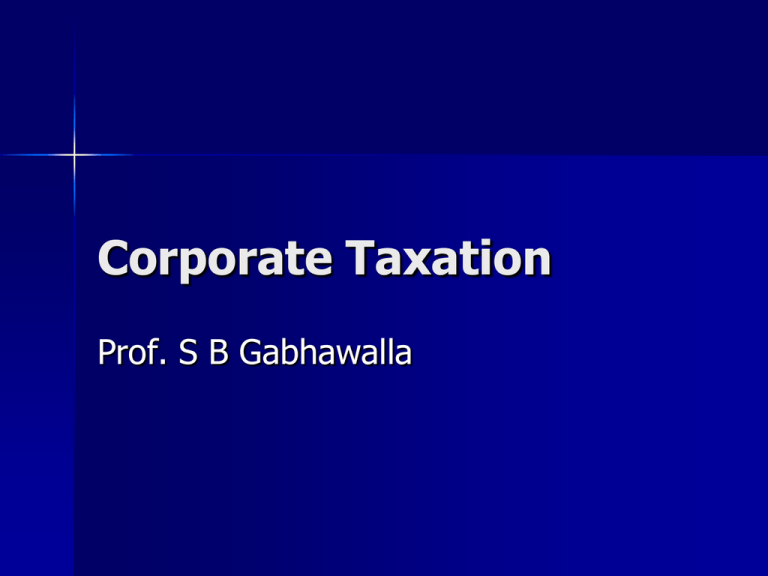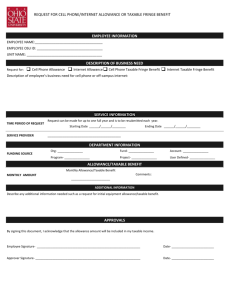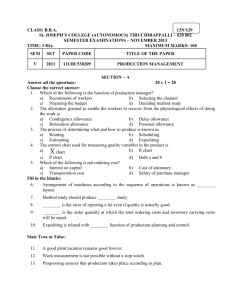Corporate Taxation
advertisement

Corporate Taxation Prof. S B Gabhawalla Course Outline Session 1. Topic Introduction to Taxation & Broad Schemes 2-4. 5-6. 7-8. Individual Taxation Corporate Taxation Allied Direct Tax Concepts 9-10. International Taxation Commodities Transaction Tax Banking Cash Transaction Tax Taxation Dividend Distribution Tax Income Tax Direct Taxes Securities Transaction Tax Wealth Tax Fringe Benefit Tax Indirect Taxes Centre State Local Customs Sales Tax/VAT Octroi Excise Profession Tax Property Taxes Service Tax Stamp Duty User Charges Income Tax: Scheme of the Act Income Receipt vs. Income – Capital vs. Revenue – Scope of Income • • • • • Exemption Exemptions Heads of Income Aggregation Rules Deductions Tax Liability H1 H2 H3 Aggregation Deductions Person TAX Income H4 H5 Scope of Income --Territorial Nexus-- --Residential Nexus-Person Resident Non Resident Income In India Taxable Taxable Outside India Taxable Non Taxable (To be refined later) Heads of Income Salaries Employer – Employee Relationship House Buildings not used for business Income from Property Business Income Capital Gains Income from Other Sources Frequency & Intention Transfer of a Capital Asset Residuary Head of Income Illustrative Format.. NAME OF THE ASSESSEE: ASSESSMENT YEAR: RESIDENTIAL STATUS: PREVIOUS YEAR ENDED ON: PERMANENT ACCOUNT NUMBER: COMPUTATION OF INCOME INCOME FROM SALARIES INCOME FROM HOUSE PROPERTY BUSINESS INCOME CAPITAL GAINS INCOME FROM OTHER SOURCES GROSS TOTAL INCOME LESS DEDUCTIONS NET TOTAL INCOME xx xx xx xx xx xx xx xx COMPUTATION OF TAX LIABILITY TAX PAYABLE ON INCOME ADD SURCHARGE ADD EDUCATION CESS ADD SECONDARY & HIGHER EDUCATION CESS GROSS TAX PAYABLE LESS TAX DEDUCTED AT SOURCE & ADVANCE TAXES NET TAX PAYABLE / REFUNDABLE xx xx xx xx xx xx xx Tax Rates: Individual : Normal Income Tax SC EC SHEC Total 0-150000 0 0 0 0 0 150001-300000 10 0 2 1 10.30 300001-500000 20 0 2 1 20.60 500001-1000000 30 0 2 1 30.90 1000001 onwards 30 10 2 1 33.99 1 1 Applicable from the first rupee of tax (Marginal Relief Available) Tax Rates: Individual : Ladies Income Tax SC EC SHEC Total 0-180000 0 0 0 0 0 180001-300000 10 0 2 1 10.30 300001-500000 20 0 2 1 20.60 500001-1000000 30 0 2 1 30.90 1000001 onwards 30 10 2 1 33.99 1 1 Applicable from the first rupee of tax (Marginal Relief Available) Tax Rates: Individual : Senior Citizens Income Tax SC EC SHEC Total 0-225000 0 0 0 0 0 225001-300000 10 0 2 1 10.30 300001-500000 20 0 2 1 20.60 500001-1000000 30 0 2 1 30.90 1000001 onwards 30 10 2 1 33.99 1 1 Applicable from the first rupee of tax (Marginal Relief Available) Tax Rates: Others Assessee / Income Tax SC EC SHEC Total 2 1 30.90 2 1 33.99 2 1 41.20 2 1 42.23 Partnership Firms & Domestic Companies 0-10000000 30 0 10000001 onwards 30 10 0-10000000 40 0 10000001 onwards 40 2.5 1 Foreign Companies 1 1 Applicable from the first rupee of tax (Marginal Relief Available) Salaries: The Starters.. Test: Employer – Employee Relation Basis of Charge: Accrual or Receipt whichever is earlier Scheme (Taxation): Primarily Gross Basis Scheme of Taxation Basic Salary Add Allowances (to the extent not exempt) Add Perquisites (as valued) Add Retirement Benefits (to the extent not exempt) Less Profession Tax Entertainment Allowance Benefits in Kind: Broad Landscape Purely Official – Not Perquisite Purely Personal & Identifiable Perquisite Purely Personal but not Identifiable – Fringe Benefit Both Personal as well as official – Fringe Benefit Allowances Exemption based on expenditure and multiple limits – House Rent Allowance – Entertainment Allowance – Leave Travel Concession/Allowance Exemption based on expenditure Exemption based on monetary limits Expenditure Allowances Allowance is based on expenditure – – – – – – – Tour Allowance Transfer Allowance Daily Allowance while on tour Helper Allowance Research Allowance Uniform Allowance Conveyance Allowance (does not include from residence to office and back) Monetary Allowances Hill Area Allowance Border Area Allowance Tribal Area Allowance Allowance for Transport Employees Compensatory Field Area Allowance Compensatory Modified Area Allowance Counter Insurgency Allowance Underground Allowance High Altitude Allowance Active Field Allowance Island Duty Allowance Children Education Allowance Rs. 100 Hostel Allowance Rs.300 Conveyance Allowance (from residence to office & back) Rs. 800 House Rent Allowance Exemption is least of – Excess of Rent Paid over 10% of Salary – 50% of salary for metro cities, 40% for others – Actual Receipt Salary means Basic, DA(if it forms a part of retirement benefits) & Commission (if it is paid as a specific percentage of sales achieved by the employee) Leave Travel Concession Fare – Based on the mode of travel for self or family – Spouse, children*, dependents For travel to any place in India For 2 journeys in a block of 4 calender years – From 1986 – Carry Forward to 5th year if unused Perquisites Taxable in all cases Rent Free/ Concessional Accommodation – 7.5%-10%-15% of salary or actual hire charges if lower – Additional 10% of the cost of furniture or actual higher charges – If accommodation in hotel, 24% of the salary or charges paid to hotel whichever is lower – If employee is paying some rent, deduct from the value Perquisites Taxable in all cases Obligation of an employee paid by the employer Premiums Paid for Life Assurance/Annuity Interest Free/ Concessional Loans – Simple Interest on maximum outstanding monthly balance except in following cases: Medical Loan for specified diseases Petty Loans upto Rs. 20000/- Nil Nil Perquisites Taxable in all cases Use of an Asset – 10% of the actual cost or hire charges paid – Exempt in case of laptops and computers, telephones and mobiles Transfer of an Asset – Sale price less the depreciated value – Depreciation Rates for this purpose Computers & Electronic Items Motor Cars Others – Depreciation for completed year 50% WDV 20% WDV 10% SLM Perquisites taxable for specified employees Medical Facilities Exempt if – – – – – – In a hospital maintained by the employer In a Government hospital In an approved hospital for prescribed diseases Mediclaim Premium, Group Mediclaim Other Medical Treatment upto Rs. 15000/Overseas Medical Treatment Treatment Cost Cost of Travel & Stay for self & family Cost of Travel & Stay for one attendant Cost of Travel excluded only if gross income < 2 lakhs Retirement Benefits Provident Fund Superannuation Fund Pensions Gratuity Encashment of unutilised leave Retrenchment Compensation Voluntary Retirement Compensation Provident Fund Statutory Prov. Fund Recognised Prov. Fund Unrecognised Prov. Fund Employers’ Contribution Exempt Exempt upto 12% of salary Exempt Employees’ Contribution Eligible for deduction Eligible for deduction Not eligible for deduction Interest Exempt Exempt upto a notified rate Exempt Withdrawals Exempt Exempt if completed 5 years Taxable Approved Superannuation Fund Employers’ Contribution exempt upto 27% of salary – Liable for FBT if exceeds Rs. 100000/- per employee Employees’ Contribution eligible for deduction Interest is exempt Pension on retirement is taxable Commutation on retirement partly exempt Payment on death totally exempt In all other cases, taxable Pensions Uncommuted Pensions – Received by the retired employee Salaries – Received by the legal heir I.O.S Commuted Pensions on retirement – If receiving gratuity also, 1/3rd of non commuted value is exempt – If not receiving gratuity, ½ is exempt – For Government employees, totally exempt Gratuity Government Employees – Exempt Covered by the Payment of Gratuity Act – 15 days salary for each year of service – Rs. 350000/– Actual Receipt Not Covered by the Payment of Gratuity Act – ½ months’ average salary for each completed year of service – Rs. 350000/– Actual Receipt Encashment of Leave Salary Government Employees – Exempt Others Cash Equivalent of earned unused leave – Earned 30 days for each completed year of service – Salary is average of last 10 months 10 months average salary Rs. 300000/Actual Receipt Income from House Property Tax on “Notional Income” Property can be: – – – – Used for own Business To exclude Used for own Residence (only 1) NIL Let Out Rent/Mkt Rent Vacant Mkt Rent Interest on Borrowed Capital available as a deduction – In case of 1 SO Prop. upto Rs. 150,000/– In all other cases, without limit Capital Gains The Starters.. Capital Receipts not taxable unless specifically included Essentials – Profits/Losses on – Transfer of a – Capital Asset Profit/Loss.. Sale Price Deductions – Cost of Acquisition – Cost of Improvement – Expenses on Transfer Capital Asset Wide definition Cannot however cover – Stock in trade – Personal assets & privileges – Agricultural Rural Land (Population < 10000) Classification as short term & long term – Equity/Preference Shares, Other listed securities & units – 12 months – Other Assets – 36 months Privileges of Long Term Indexation Benefits Substitution of Fair Market Value Lower Rate of Tax @ 20% Special Scheme for listed securities Eligible for Re-investment Benefits Listed Securities… Position from 01.10.2004 (if STT is paid) – Long Term - exempt – Short Term – concessional tax rate of 15% The concessional regime does not apply to – Off Market Transactions – Shares held as “stock in trade” Privileges of Long Term Reinvestment Benefits Residential House – Residential House – Reinvest Capital Gains – Purchase 1 year before/2 years after OR – construct 3 years after Any – Residential House – Reinvest Sale Consideration – Purchase 1 year before/2 years after OR – construct 3 years after Any – Specified Capital Gains Bonds Reinvest Capital Gains Within six months Lock in period of 3 years for the reinvested asset Some Important Exemptions Agricultural Incomes Specified Interest Incomes Income of Charitable Institutions Dividend Income Gifts Received upto Rs. 50,000/- Deductions Generally available only to residents Subject to the existence of income Broad Categories – For certain payments – For certain incomes – In certain situations Specified Investments A maximum amount of Rs. 1,00,000/- is deductible No inter-sectoral caps Eligible Investments – – – – – – – – Provident Fund / Public Provident Fund Contribution to Pension Fund LIC Premiums National Savings Certificate Purchase of Residential House Repayment of Housing Loan – Principal Component Education Expenses of Children Contribution to ELSS / ULIP Mediclaim Premium Payments covered – Self & Spouse – Dependent Parents – Dependent Children Deduction available upto – Rs. 15000 generally – Rs. 20000 for senior citizens Donations Calculate Qualifying Amount – Eligible without limit – Eligible with limit of 10% – Not Eligible Calculate Deductible Amount – 100% Deduction – 50% Deduction Taxability of Business Income Tax on Net Income from Business Net Income = (+) Gross Receipts (-) Expenses Role of Accounting for both (+) & (-) Net Income is therefore as determined by the books of accounts & method of accounting followed Differing Objectives lead to disturbance of the base Net Profit as per Profit & Loss Account Add: – Items debited but not allowed – Items not credited but taxable Less: – Items credited but exempt/ taxable elsewhere – Items not debited but allowed Taxable Income What are these adjustments? Expenses specifically allowed Expenses disallowed Residuary Category Not Capital Not Violation of Law For the Purposes of Business Depreciation Expenses specifically allowed: Expenditure on Scientific Research Revenue Expenditure related to business Capital Expenditure related to business (excluding cost of land) Donation to Scientific Research Associations/National Laboratory/ University/IIT/Company (1.25 times weighted deduction) Revenue & Capital Expenditure (not being land & building) on approved in-house projects (1.5 times weighted deduction) Residuary Category Not Capital in Nature For the purposes of business – Personal Expenditure not allowed Incurred during the previous year Not for any Violation of Law (eg. Penalties) Amounts not deductible Income Tax/ Wealth Tax/Tax on Perquisites / Fringe Benefit Tax Provisions made for non statutory employee welfare funds Payments to partners by a partnership firm – Remuneration in excess of limits – Interest on capital in excess of 12% p.a. Amounts not deductible: Payments to relatives Payments to relatives in excess of fair value Relatives defined to include: spouse, brother, sister, lineal ascendant and descendant Receipts not covered No corresponding adjustment in the assessment of the relative Amounts not deductible: Payments without TDS Overseas / Domestic Payments are deductible only if the applicable taxes are deducted at source and paid If the payments are disallowed in the current year because the taxes are not deducted or paid, they shall be allowed in the year of payment Amounts not deductible : Cash Expenditure Expenditure above Rs. 20000/- to be made by account payee cheque otherwise the expense will be disallowed Exceptions carved out in genuine cases like – Payments to Government Agencies, payments on a bank holiday, payments in a village not serviced by a bank, etc. How to move out?? Amounts not deductible: Unpaid Statutory Dues Covers the following dues – – – – – – Tax, duty or cess Bonus/Commission to employees Interest on Loan of financial institutions Int. on term loan of scheduled bank Leave Salary to employee Contribution to PF/SAF/SWS Deduction available only if paid before the due date of filing return of income If not paid, can claim deduction in the year of payment Depreciation: Concept Not on individual assets but on block of assets Written Down Value Method at rates specified In the year of purchase – Full year’s depreciation unless the asset put to use for less than 180 days (half depreciation) In the year of sale – No Depreciation Block of Assets – Same group & same rate Depreciation: Block of Assets & Rate Buildings used for residential purposes (5%) Other Buildings (10%) Furniture & Fixtures (10%) Plant & Machinery (15%) Motor Cars (15%) Computers & Software (60%) Intangible Assets (25%) Pollution Control Equipments (100%) Energy Saving Devices (80%) Depreciation: Written Down Value Opening WDV (a) xx Add Actual Cost of Assets Purchased – Used > 180 days – Used < 180 days (b) (c) xx xx Less Sale Price of Assets Sold (d) xx Closing WDV (e) = ( a + b + c - d) xx Depreciation : WDV (Contd.) If Closing WDV is negative – Treat the amount as Short Term Capital Gains Adjustable against business losses to the extent of depreciation written off – No Depreciation will be available even if there are other assets in the block If Closing WDV is positive but there are no assets in the block – Treat the amount as Short Term Capital Loss – No Depreciation will be available even though the WDV is positive Depreciation : WDV (Contd.) If Closing WDV is positive and there are assets in the block – Do not calculate profit or loss but provide depreciation on (e) – If e > c Depreciation = full * (a+b-d) + half * c – If e < c Depreciation = half * e Tax Deducted at Source Deduction at the stage of payment Attempts to plug – Non reporting of income – Lower reporting of income Improves cash flow for the Government Additional Burden for the Assessee TDS on Salaries At the “average rate of tax” Both Residents and Non Resident covered Allowances to be considered with proof – No proof be insisted for HRA upto Rs. 3000 Deductions & Rebates to be allowed Multiple Employers? Multiple Sources of Income – Only Loss from HP can be considered TDS on certain payments Nature of Payment Rate for Non Corporate Rate for Corporate Interest 10% 20% Commission 10% 10% Rent for Immoveable Properties 15% 20% Rent for Machineries, etc. 10% 10% Contractors 2% 2% Subcontractors and Advertisements 1% 1% Professional Fees 10% 10% TDS on non residents All incomes covered All Payers covered At Applicable Rates Application by payer for determination of income Application by receiver for non deduction of tax Application by receiver for lower deduction Procedures: Traditional Obtain Tax Deduction Number Deduct Tax Pay to the Government Issue TDS Certificate File TDS Returns Procedures: DEMAT Quarterly e-TDS Return to be filed in soft format The NSDL to consolidate all TDS based on PAN Issue a consolidated TDS Certificate to each assessee Many procedural issues likely to arise Non Compliance Consequences Recovery of the TDS Amount Interest on delayed payment / non payment Penalty for non compliance Disallowance of Expenditure Minimum Alternate Tax To compensate for discrepancies between accounting and taxation principles Accept the net profit as per Companies Act and make specific adjustments to convert it into book profits Pay minimum tax @ 10 % of the book profits if the actual tax liability is lower Does it really serve the purpose ? Dividend Distribution Tax Dividends – Tax Free in hands of shareholders, liable for DDT @ 15% for the company Brings to light the problems relating to – Earnings Stripping – Capital Gearing – Cascading Effect on Capital Structuring Scope of Income --Territorial Nexus-- --Residential Nexus-Person Resident Non Resident Income In India Taxable Taxable Outside India Taxable Non Taxable (Simplified Version) The Genesis of the Problem.. Source Based Taxation – Not Acceptable to Developed Nations Residence Based Taxation – Not Acceptable to Developing Nations – Prone to Misuse Combination of Source & Residence Based Taxation is a universal phenomenon This leads to problems of double taxation Understanding DT Conflicts Source Resident Conflicts – German company offers technical support to Indian company and charges FTS Resident Resident Conflicts – A US Citizen stays in India for more than 182 days Resolving R-R Conflicts Successive Tests (for individuals) – – – – Permanent Home Centre of Vital Interests Nationality Mutual Agreement Procedure Successive Tests (for others) – Place of Effective Management The US Citizen will pay tax in US & not in India Resolving S-R Conflicts Sharing of the Tax Revenue Concept of Active & Passive Incomes Allocate these incomes to respective states Remember, Resident State is always supreme! Resolving S-R Conflicts OECD Model Convention – Source State to tax only active incomes – Resident State to tax the passive incomes – Resident State may still tax active incomes but should eliminate double taxation Suitable for developed nations but not acceptable to developing countries Resolving S-R Conflicts UN Model Convention – Source State to tax active incomes – Source State may tax passive incomes but at concessional rate – Resident State may tax all incomes but should eliminate double taxation Most Indian treaties based on the UN Model Income Distributive Rules – Rights of the Source State Nature of Income OECD Model UN Model From Immoveable Properties Full Tax Full Tax Business Profits In case of PE In case of PE Dividends No Tax Lower Tax Interest No Tax Lower Tax Royalties No Tax Lower Tax Fees for Technical Services No Tax Lower Tax Capital Gains from properties Full Tax Full Tax Capital Gains from Shares No Tax Full Tax Independent Personal Services In case of FB In case of FB Dependent Personal Services Full Tax Full Tax Resident State Taxation Right of the resident state to tax incomes is unfettered Tax to be paid in Resident State = Tax Payable – Tax Paid Overseas Therefore tax saved in source state may get nullified in the resident state Proper choice of a resident state is therefore the pivot to international tax planning The Solution to one problem germinates another problem.. Tax Havens… No Tax Jurisdictions – Bermuda, Cayman Islands No Tax on foreign source Incomes – Hongkong, Panama No Tax on foreign source Incomes of Companies owned by non residents – Barbados, Isle of Man Special Laws make them ideal – British Virgin Islands, Switzerland Treaty Networks can be used – Netherlands, Mauritius International Transfer Pricing R&D A Ltd Luxembourg Multitude of business entities and jurisdictions over the value chain Mfg. Testing Mktg. Brand Fin. Sales & Distn. B Ltd B Ltd C Ltd D Ltd E Ltd B Ltd India India India Austria Mauritius China Transfer Pricing Framework Any income, expense or cost sharing In an “International Transaction” Shall be determined at “arms’ length price” Arms’ Length Price Comparable Uncontrolled Price Resale Price Method Cost Plus Method (CUP) (RPM) (CPM) Transactional Net Margin Method (TNMM) Profit Split Method (PSM) FAR Analysis Indian Party Foreign Party FUNCTIONS ASSETS RISKS Check for a simpler party if it could be categorised as manufacturer or distributor This was just an aerial view of the sea, not an exercise in swimming… Thank You


